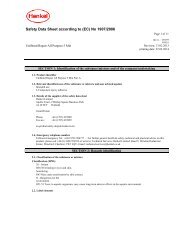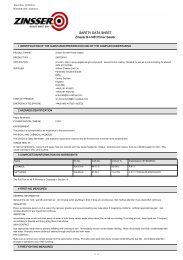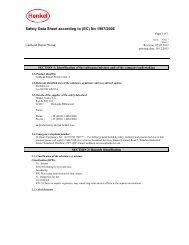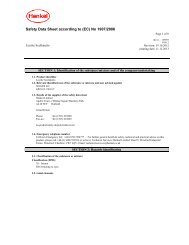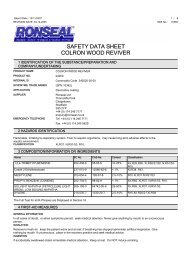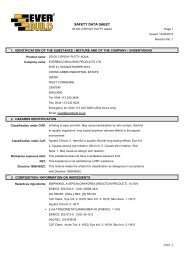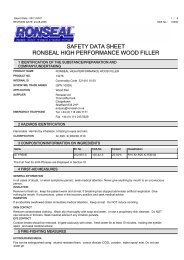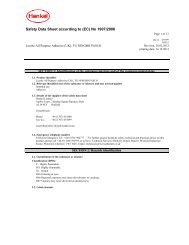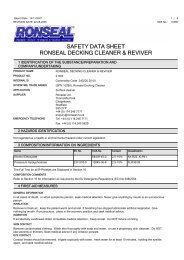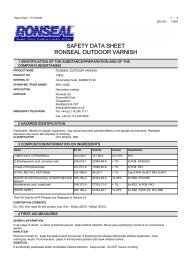safety data sheet ronseal kitchen and bathroom touch-up ... - Toolbank
safety data sheet ronseal kitchen and bathroom touch-up ... - Toolbank
safety data sheet ronseal kitchen and bathroom touch-up ... - Toolbank
You also want an ePaper? Increase the reach of your titles
YUMPU automatically turns print PDFs into web optimized ePapers that Google loves.
Report Date : 21/04/2006 2 / 5REVISION DATE: 12-04-2006 SDS No.: 10504RONSEAL KITCHEN AND BATHROOM TOUCH-UP ENAMELEYE CONTACTContact lenses should be removed. Irrigate copiously with clean, fresh water for at least 10 minutes, holding the eyelidsapart, <strong>and</strong> seek medical advice.5 FIRE-FIGHTING MEASURESEXTINGUISHING MEDIAFire can be extinguished using: alcohol resistant foam, carbon dioxide (CO2), powder, water spray/ mist. Do not usewater jet.SPECIAL FIRE FIGHTING PROCEDURESFire will produce dense black smoke containing hazardous products of combustion (see Section 10). Exposure todecomposition products may be hazardous to health. Appropriate self-contained breathing apparatus may be required.Cool closed containers exposed to fire with water spray. Do not allow run-off from fire fighting to enter drains orwatercourses.6 ACCIDENTAL RELEASE MEASURESSPILL CLEAN UP METHODSExclude sources of ignition <strong>and</strong> ventilate the area. Exclude non-essential personnel. Avoid breathing vapours. Refer toprotective measures listed in Section 7 <strong>and</strong> 8. Contain <strong>and</strong> collect spillage with non-combustible absorbent materials, e.g.s<strong>and</strong>, earth or vermiculite, <strong>and</strong> place in a suitable container for disposal in accordance with the waste regulations (seeSection 13). Clean preferably with a detergent; avoid the use of solvents. If the product enters drains or sewers,immediately contact the local water company; in the case of contamination of streams, rivers or lakes, the relevantenvironment agency.7 HANDLING AND STORAGEUSAGE PRECAUTIONSKeep away from heat, sparks <strong>and</strong> open flame. Vapours are heavier than air <strong>and</strong> may spread along floors. They may formexplosive mixtures with air. Prevent the creation of flammable or explosive concentrations of vapour in air <strong>and</strong> avoidvapour concentrations higher than the occ<strong>up</strong>ational exposure limits. Smoking, eating <strong>and</strong> drinking should be prohibited inareas of storage <strong>and</strong> use. Prevent airborne concentrations higher than the occ<strong>up</strong>ational exposure limits. Provide goodventilation. Avoid inhalation of vapours. Avoid inhalation of dust.Where possible, wet flatting methods or chemical strippers should be used to avoid the creation of dust.For Occ<strong>up</strong>ational Exposure Controls, refer to Section 8.The Manual H<strong>and</strong>ling Operations Regulations may apply to the h<strong>and</strong>ling of containers/packages of this product.STORAGE PRECAUTIONSKeep containers tightly closed. Observe the label precautions. Store between 5°C <strong>and</strong> 25°C. Keep in a cool, dry, wellventilated place, away from sources of heat, ignition <strong>and</strong> direct sunlight. No smoking.The principles contained in the HSE Guidance Note: Storage of Packaged Dangerous Substances, should be observedwhen storing this product.To avoid the risk of spillage, always store <strong>and</strong> transport in a secure <strong>and</strong> <strong>up</strong>right position.8 EXPOSURE CONTROLS/PERSONAL PROTECTIONNameXYLENEPROPAN-2-OLBUTANONEBUTYL ACETATE -normStdLT - ppm LT - mg/m3 ST - ppm ST - mg/m3WEL 50 ppm(Sk) 220 mg/m3(Sk) 100 ppm(Sk) 441 mg/m3(Sk)WEL 400 ppm 999 mg/m3 500 ppm 1250 mg/m3IOELV 200 ppm(Sk) 600 mg/m3(Sk) 300 ppm(Sk) 899 mg/m3(Sk)WEL 150 ppm 724 mg/m3 200 ppm 966 mg/m3TITANIUM DIOXIDEWELINGREDIENT COMMENTSWEL = Workplace Exposure Limits SUP = S<strong>up</strong>plier's recommendation.4 mg/m3 resp.dustENGINEERING MEASURESProvide adequate ventilation. Where reasonably practicable, this should be achieved by the use of local exhaustventilation <strong>and</strong> good general extraction. If these are not sufficient to maintain concentrations of particulates <strong>and</strong>/or solventvapours below the relevant occ<strong>up</strong>ational exposure limits, suitable respiratory protective equipment should be worn.RESPIRATORY EQUIPMENTIf exposure to hazardous substances identified above cannot be controlled by the provision of local exhaust ventilation <strong>and</strong>good general extraction, suitable respiratory protective equipment should be worn.



